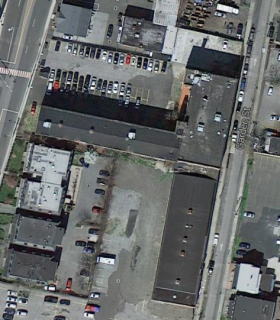Mill Record Stamford
RETURN TO ‘FIND MILLS’Disclaimer: Content for these properties was compiled in 2014-2017 from a variety of sources and is subject to change. Updates are occasionally made under Property Information, however the Connecticut Trust for Historic Preservation (dba Preservation Connecticut) makes no representation or warranty that the information is complete or up-to-date.
- Complex Name (Common)
- Blickensderfer Manufacturing Company PARTIALLY DEMO’D
- Complex Name (Historic)
-
- Blickensderfer Manufacturing Company
- Address or Location
- 650 Atlantic Street, South End, Stamford
- County
- Fairfield
- Historic Designation
- Associated Mill Community
- n/a

- Historic Information
Companies Associated w/Complex
- Blickensderfer Manufacturing Co. 1895-1919
- L.R. Roberts Company 1919-1926
- Pitney Bowes Company 1954-
- Remington Noiseless Typewriter Co. 1927-c.1945
- Schick Company 1945-1954
Use (Historic)
Largest Documented Workforce
30 (1896)
Historic Narrative
Note: the two 19th century buildings are contributing resources to the South End Historic District; the complex as a whole is potentially eligible for individual listing. The Blickensderfer Manufacturing Company was established by a Stamford, Connecticut, typewriter salesman named George Canfield Blickensderfer. In the late 1880s, Blickensderfer filed several patents for typewriters that were equipped with a new system for producing type: rather than mechanical arms, each affixed to a lettered key, his typewriters utilized what is referred to as a typewheel (patent filed 1888). The typewheel contained all of the characters present on other typewriters, but on a single cylindrical mechanism that rotated and stamped upon the operator’s key-command. This element had several advantages that won the model acclaim at several high-profile expositions. The first was its simplicity and minimalism. With only several hundred parts, the Blickensderfer was less likely to have mechanical failure than standard typewriters, which often contained several thousand parts. Fewer components also meant lighter weight, making the Blickensderfer a perfect candidate for the portable market, a market plagued by unreliable and overpriced machines. Lastly, the typewheel could be easily swapped so that the operator could use a variety of fonts; traditional typewriters did not have the capability of multiple fonts. Around 1895, Blickensderfer had attracted enough interested investors to start a shop on Garden Street in Stamford. It was a small steam-powered factory (now demolished). By 1896, the company, with approximately thirty employees, had already outgrown the space and the factory on nearby Atlantic Street was erected. In addition to advances in type movement and portability, Blickensderfer also produced an electric typewriter in 1902 – reported to be the second ever produced (some sources claim it to be the first). He also experimented with aluminum casting to further reduce the weight of his machines. Despite his ingenuity, his advances were ahead of his time and never became very popular. The electric typewriter, for example, would not become prevalent until the mid-twentieth century, when it was produced by IBM. By 1910, sales had begun to decline rapidly and since much of the Blickensderfer market was overseas, the ban on trade with many countries at the start of the First World War severely crippled the company. While the firm did receive some war-contacts to produce munitions for the military, typewriter production fell. After George Blickensderfer died in 1917, the company was sold to the L. R. Roberts Company, another typewriter manufacturer, which operated in the building from 1919 to 1926. The Roberts Company sold the Blickensderfer name and Atlantic Street factory in 1927 to the Remington-Noiseless Typewriter Company, which discontinued the Blickensderfer line in 1928. By 1929, the building had become Remington’s Remington Rand Laboratory, presumably used for research and development. Between 1929 and 1945, but most likely in 1945, when Remington opened another research laboratory in South Norwalk, the buildings changed hands to the Schick Company, an electric razor manufacturer. Schick experienced serious labor disputes and at one point in 1945, saw 500 workers go on strike. In 1954, Schick moved its operations, with nearly 1,000 workers, from Stamford to Lancaster, Pennsylvania. The buildings were sold to Pitney Bowes Company as a transitional storage facility. See also Today in Connecticut History: Invention of the Portable Typewriter at https://todayincthistory.com/2019/04/12/april-12-invention-of-the-portable-typewriter/
- Architectural Information
Number of Existing Buildings
Three (3) primary blocks.
Dates of Construction
1896, 1936, c.1942
Architect
Emmens & Abbott 1936 addition; Leo F. Caproni c.1942 addition (demo'd)
Builder
Vuono Construction Co 1936 addition and c.1942 addition (demo'd)
Building Type
Architectural Description
The complex consists of three blocks in a T-Shape. The oldest building, perpendicularly to Atlantic Street, was under construction in 1896 and likely finished in 1897 and 1898. It is a rectangular, three-story, brick building with a gable roof and segmented arch windows. A first-floor addition or attached structure along the exterior of this building has left scars on the red brick. Scars on the north façade also show the location of a previously removed stair tower. Attached to the east is a wider, rectangular three-story brick pier block with flat roof built between 1930 and 1951. Attached to the south is one story brick building constructed during the same period. The 1962 edition of the AIA Directory lists a commission from Pitney Bowes in Stamford for Leo F. Caproni (it could have been at facility on Pacific Street south of Walnut Street, now demolished).
Exterior Material(s)
Structural System(s)
Roof Form
Roof Material
Power Source
Condition
Good, Fair, Deteriorated
Condition Notes
n/a
- Property Information
-
Specific Location
The Bickensderfer Manufacturing Company is located between Atlantic and Garden Streets, several hundred yards south of Dock Street.
Adjacent To
n/a
Exterior Visible from Public Road?
Yes
Parcel ID / Assessor Record Link
- 003/ 1400 / Link →
Acreage
2.5
Use (Present)
- Sources
-
Form Completed By
Mike Forino
Date
August 2014
Bibliography
- 1947 Industrial Directory of Connecticut.
- The Hartford Courant, 1905-1955.
- Snaborn Maps, Stamford, CT, 1896-1951.
- AIA Directory (R. R. Bowker, 1962)
- Representative View(s)Click on image to view full file









